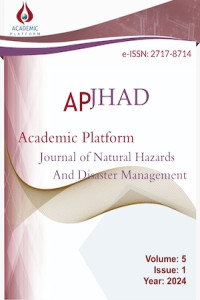Öz
This paper presents a seismic retrofit of an industrial-type precast reinforced concrete building structure using friction dampers. The project consisted of retrofitting two precast reinforced concrete buildings, one of which will be presented in this paper. Precast concrete is one of the industrial structures' most preferred construction methods due to its low cost, fast construction, and availability in rural areas. Unfortunately, most structures constructed before “Specification for Buildings to be Built in Seismic Zones (TBEC-2018) [1]” are not sufficiently engineered and are expected to perform poorly when exposed to a significant seismic event. The general characteristic of precast reinforced concrete buildings built before TBEC-2018 is their relatively high concrete quality (compared to cast-in-place reinforced concrete buildings) and better reinforcement workmanship. But they have some characteristic weaknesses as well. Weak beam-column connections, high drift ratios due to heavy beams, instability problems, and lack of frame behavior can be considered primary weaknesses. General classical retrofitting techniques include increasing beam/column sections or adding new reinforced concrete or steel members to the system or FRP (fiber-reinforced polymer) wrapping. Mostly classical retrofitting needs additional foundations. All these techniques require a long construction period, causing evacuation and stopping building usage. Because stopping the production cost can be tolerated by the owners, a retrofitting approach that can be assembled during the normal function of the industrial structures is required. As a result of this requirement, friction dampers are selected as the supplemental energy dissipation device. ASCE 41-17 [2] and ASCE 7-16 [3] are employed for the damper design and damping calculations. Before the damper study, some instability and weak connection problems are solved by traditional strengthening measures. The most effective damper configuration and capacities are selected after an iterative trial-and-error linear study using the simplified methods developed by PROMER. Nonlinear push-over analyses are conducted after linear pre-studies. Finally, a nonlinear time-history analysis is performed for confirmation of the results. It is shown that the proposed retrofit scheme satisfies the desired performance goals for both DD-1 [1] and DD-2 [1] events. Overall, it is considered that the proposed retrofit scheme with dampers provides the optimal solution for the project stakeholders from a performance, design, constructability, and economic point of view. Some application visuals will be presented, and methods will be explained in detail in the article. The friction damper behavior is based on the rotational friction hinge concept. The dampers increase building damping, causing a decrease in earthquake demand. As a result, dampers provide passive energy dissipation and protect buildings from structural and nonstructural damage during moderate and severe earthquakes.
Anahtar Kelimeler
Retrofitting friction dampers precast structures earthquake protection passive control
Destekleyen Kurum
Promer Cons. Eng.
Kaynakça
- [1] TBEC-2018- Turkish Building Earthquake Code
- [2] ASCE 41-17 Seismic Evaluation and Retrofit of Existing Buildings; American Society of Civil Engineers: Reston, VA, USA, 2017.
- [3] ASCE 7-16 Minimum Design Loads and Associated Criteria for Buildings and Other Structures 2017
- [4] Ersoy, U., Özcebe, G. and Tankut, T., (2000), 1999 Observed damages of precast structures in Marmara and Düzce Earthquakes. 10. Prefabrication symposium book page 1, Istanbul
- [5] Özmen, G., Yüzügüllü, O, and Zorbozan, M., (1997), Evauliation of TBEC-2018 for prefabricated structures. Turkish Earthquake Foundation publishments. TR 97-006, Istanbul.
- [6] Palancı.M and Şenel Ş.M.” Rapid seismic performance assessment method for one story hinged precast buildings” Structural Engineering and Mechanics 48(2) 257-274 (2013).
- [7] Cahit Gürer Kocatepe Univercity Yapı Teknolojileri II.
- [8] Etabs Ver.18 : A finite element based structural analysis software published by CSI (Computers & Structures Inc.) based on North California. Please refer to www.csiamerica.com for detailed information.
- [9] Erkuş B, Yıldırım S, Güler M.D., Özer C, Sütçü F, Alhan C. (2019) Seismic design of structures with dampers, part II: A proposal for design basis for applications in Turkey. 5th International Conference on Earthquake Engineering and Seismology (5ICEES).
- [10] Yıldırım S., Güler M.D., Özer C., Sütçü F., Alhan C. ve Erkuş B. (2019) Seismic design of structures with dampers, part I: review of international standards. 5th International Conference on Earthquake Engineering and Seismology (5ICEES).
Öz
Kaynakça
- [1] TBEC-2018- Turkish Building Earthquake Code
- [2] ASCE 41-17 Seismic Evaluation and Retrofit of Existing Buildings; American Society of Civil Engineers: Reston, VA, USA, 2017.
- [3] ASCE 7-16 Minimum Design Loads and Associated Criteria for Buildings and Other Structures 2017
- [4] Ersoy, U., Özcebe, G. and Tankut, T., (2000), 1999 Observed damages of precast structures in Marmara and Düzce Earthquakes. 10. Prefabrication symposium book page 1, Istanbul
- [5] Özmen, G., Yüzügüllü, O, and Zorbozan, M., (1997), Evauliation of TBEC-2018 for prefabricated structures. Turkish Earthquake Foundation publishments. TR 97-006, Istanbul.
- [6] Palancı.M and Şenel Ş.M.” Rapid seismic performance assessment method for one story hinged precast buildings” Structural Engineering and Mechanics 48(2) 257-274 (2013).
- [7] Cahit Gürer Kocatepe Univercity Yapı Teknolojileri II.
- [8] Etabs Ver.18 : A finite element based structural analysis software published by CSI (Computers & Structures Inc.) based on North California. Please refer to www.csiamerica.com for detailed information.
- [9] Erkuş B, Yıldırım S, Güler M.D., Özer C, Sütçü F, Alhan C. (2019) Seismic design of structures with dampers, part II: A proposal for design basis for applications in Turkey. 5th International Conference on Earthquake Engineering and Seismology (5ICEES).
- [10] Yıldırım S., Güler M.D., Özer C., Sütçü F., Alhan C. ve Erkuş B. (2019) Seismic design of structures with dampers, part I: review of international standards. 5th International Conference on Earthquake Engineering and Seismology (5ICEES).
Ayrıntılar
| Birincil Dil | İngilizce |
|---|---|
| Konular | Deprem Mühendisliği |
| Bölüm | Research Articles |
| Yazarlar | |
| Yayımlanma Tarihi | 30 Haziran 2024 |
| Gönderilme Tarihi | 16 Temmuz 2023 |
| Yayımlandığı Sayı | Yıl 2024 Cilt: 5 Sayı: 1 |


